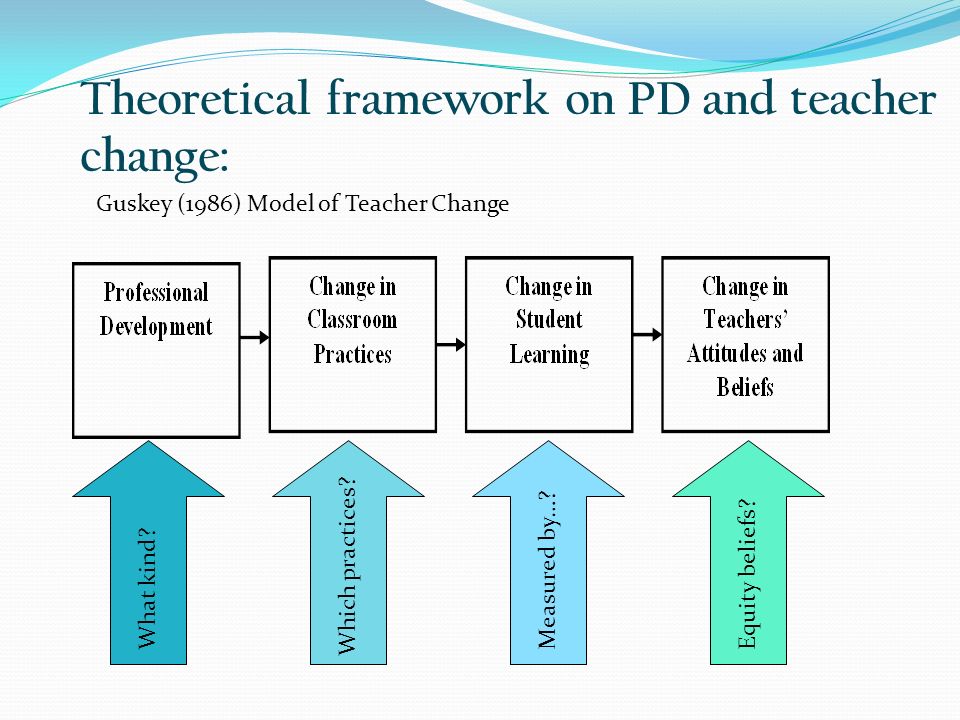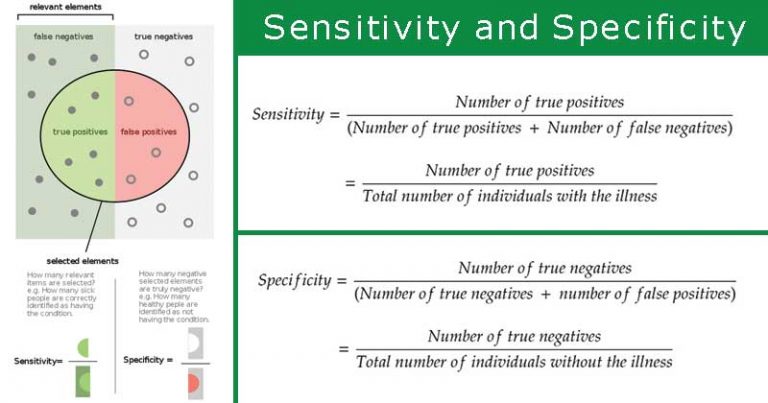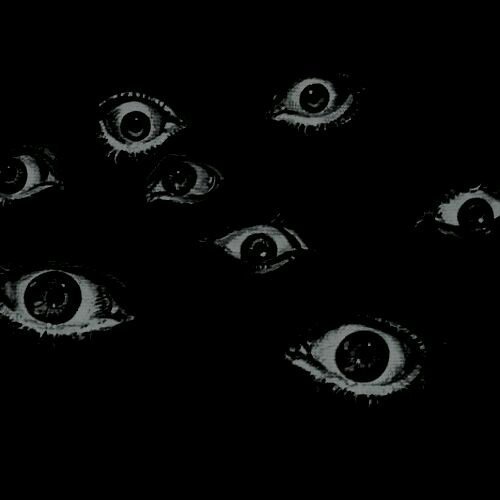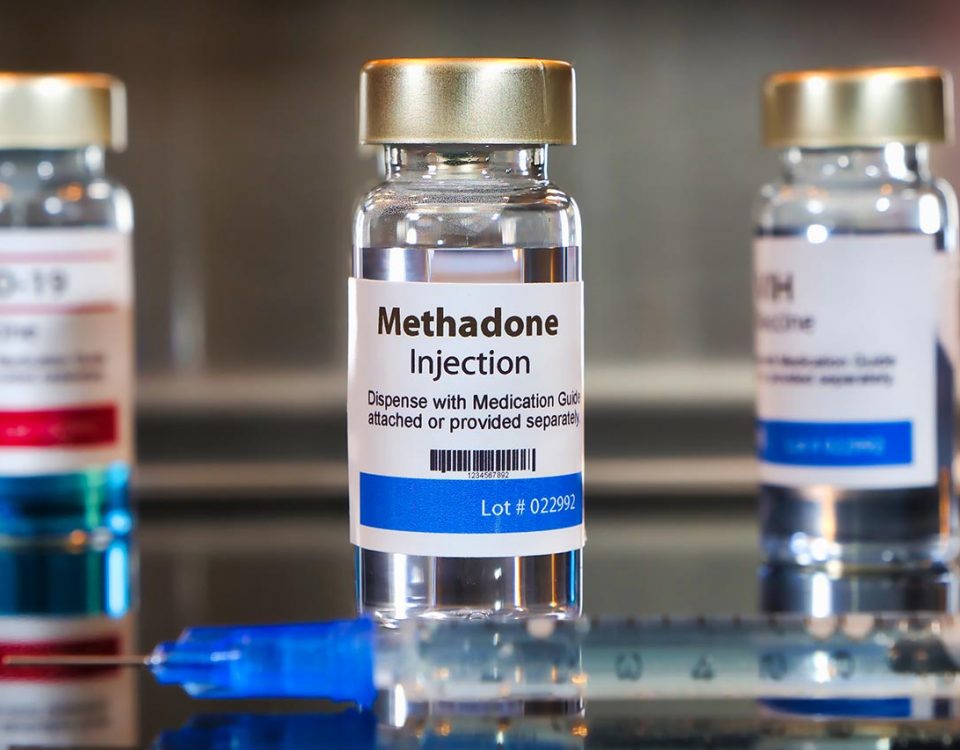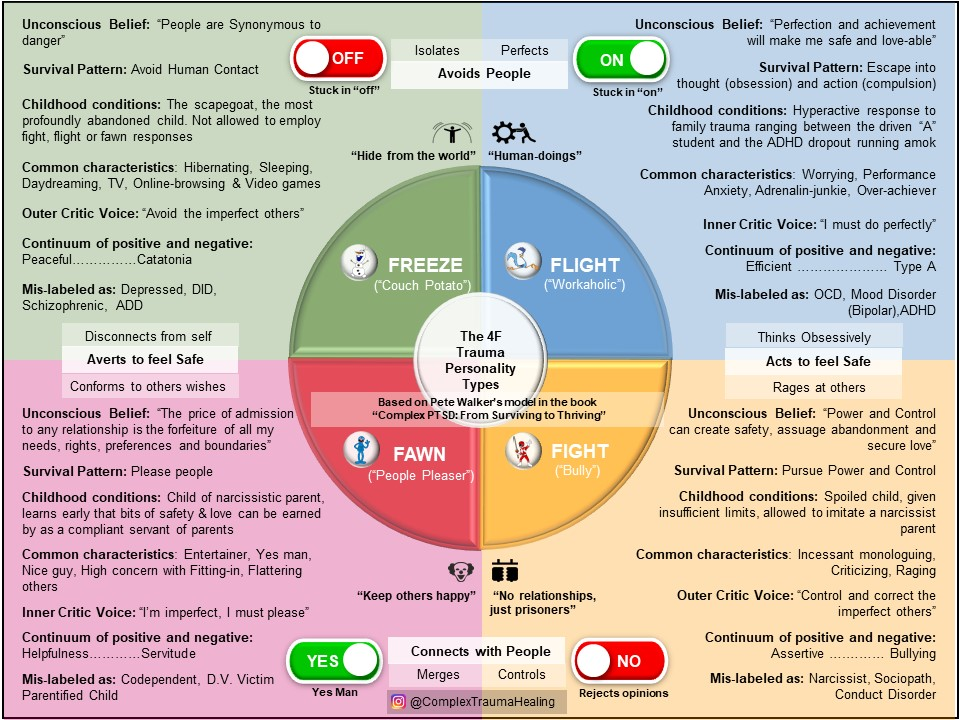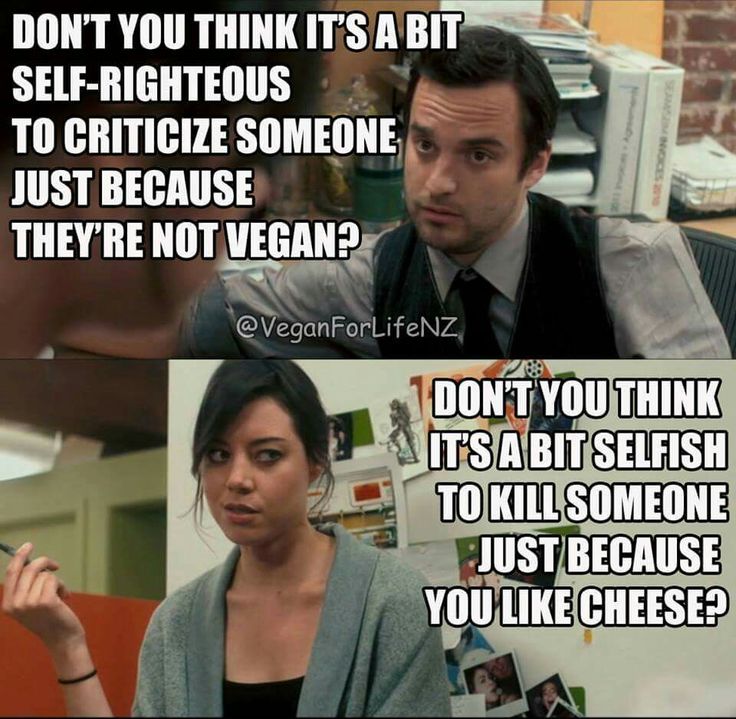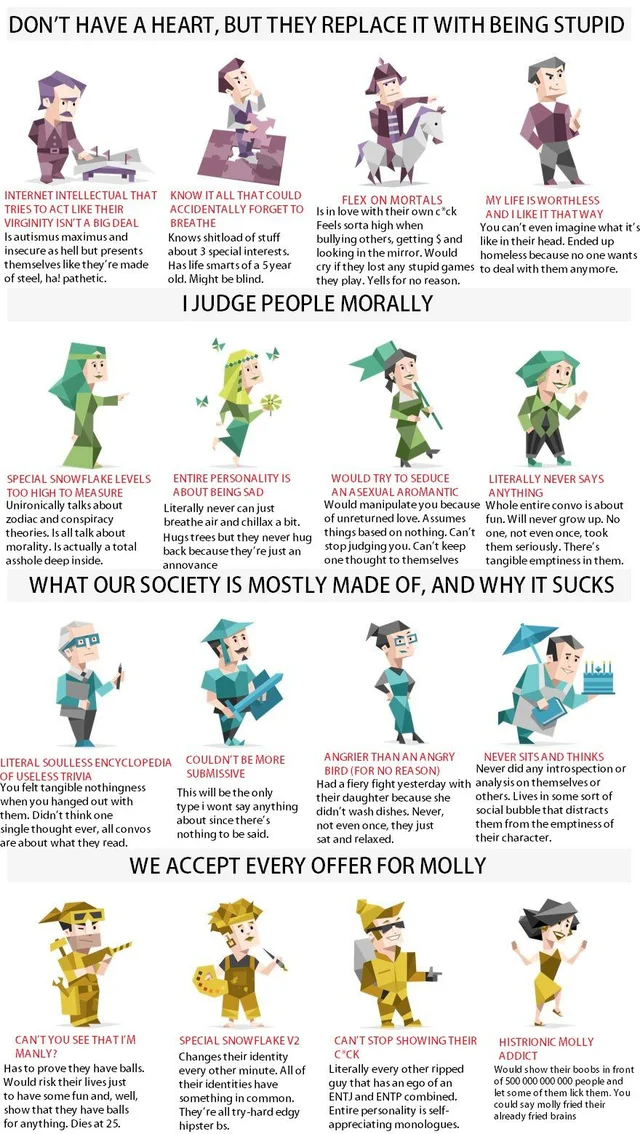Theoretical model of change
The Transtheoretical Model (Stages of Change)
The Transtheoretical Model (also called the Stages of Change Model), developed by Prochaska and DiClemente in the late 1970s, evolved through studies examining the experiences of smokers who quit on their own with those requiring further treatment to understand why some people were capable of quitting on their own. It was determined that people quit smoking if they were ready to do so. Thus, the Transtheoretical Model (TTM) focuses on the decision-making of the individual and is a model of intentional change. The TTM operates on the assumption that people do not change behaviors quickly and decisively. Rather, change in behavior, especially habitual behavior, occurs continuously through a cyclical process. The TTM is not a theory but a model; different behavioral theories and constructs can be applied to various stages of the model where they may be most effective.
The TTM posits that individuals move through six stages of change: precontemplation, contemplation, preparation, action, maintenance, and termination. Termination was not part of the original model and is less often used in application of stages of change for health-related behaviors. For each stage of change, different intervention strategies are most effective at moving the person to the next stage of change and subsequently through the model to maintenance, the ideal stage of behavior.
- Precontemplation - In this stage, people do not intend to take action in the foreseeable future (defined as within the next 6 months). People are often unaware that their behavior is problematic or produces negative consequences. People in this stage often underestimate the pros of changing behavior and place too much emphasis on the cons of changing behavior.
- Contemplation - In this stage, people are intending to start the healthy behavior in the foreseeable future (defined as within the next 6 months). People recognize that their behavior may be problematic, and a more thoughtful and practical consideration of the pros and cons of changing the behavior takes place, with equal emphasis placed on both.
 Even with this recognition, people may still feel ambivalent toward changing their behavior.
Even with this recognition, people may still feel ambivalent toward changing their behavior. - Preparation (Determination) - In this stage, people are ready to take action within the next 30 days. People start to take small steps toward the behavior change, and they believe changing their behavior can lead to a healthier life.
- Action - In this stage, people have recently changed their behavior (defined as within the last 6 months) and intend to keep moving forward with that behavior change. People may exhibit this by modifying their problem behavior or acquiring new healthy behaviors.
- Maintenance - In this stage, people have sustained their behavior change for a while (defined as more than 6 months) and intend to maintain the behavior change going forward. People in this stage work to prevent relapse to earlier stages.
- Termination - In this stage, people have no desire to return to their unhealthy behaviors and are sure they will not relapse.
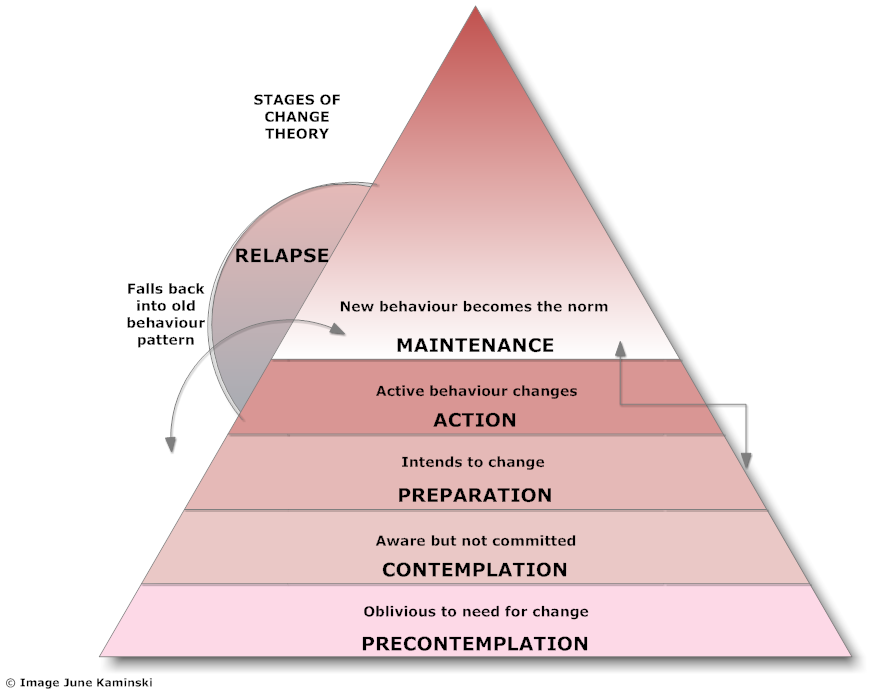 Since this is rarely reached, and people tend to stay in the maintenance stage, this stage is often not considered in health promotion programs.
Since this is rarely reached, and people tend to stay in the maintenance stage, this stage is often not considered in health promotion programs.
To progress through the stages of change, people apply cognitive, affective, and evaluative processes. Ten processes of change have been identified with some processes being more relevant to a specific stage of change than other processes. These processes result in strategies that help people make and maintain change.
- Consciousness Raising - Increasing awareness about the healthy behavior.
- Dramatic Relief - Emotional arousal about the health behavior, whether positive or negative arousal.
- Self-Reevaluation - Self reappraisal to realize the healthy behavior is part of who they want to be.
- Environmental Reevaluation - Social reappraisal to realize how their unhealthy behavior affects others.
- Social Liberation - Environmental opportunities that exist to show society is supportive of the healthy behavior.
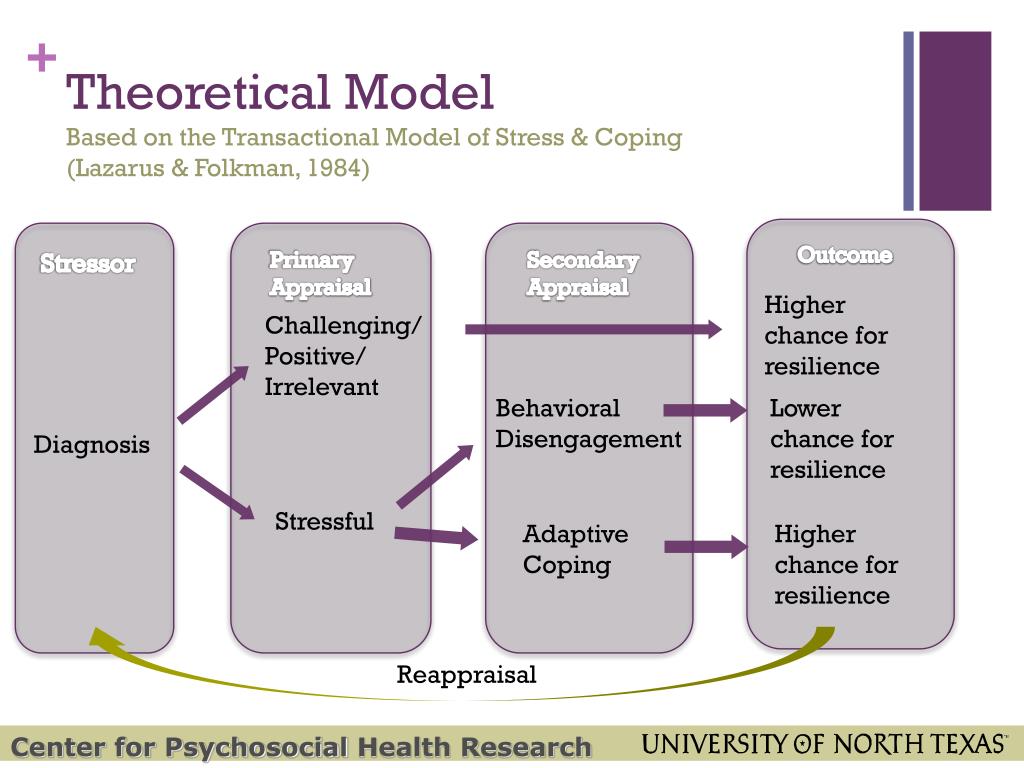
- Self-Liberation - Commitment to change behavior based on the belief that achievement of the healthy behavior is possible.
- Helping Relationships - Finding supportive relationships that encourage the desired change.
- Counter-Conditioning - Substituting healthy behaviors and thoughts for unhealthy behaviors and thoughts.
- Reinforcement Management - Rewarding the positive behavior and reducing the rewards that come from negative behavior.
- Stimulus Control - Re-engineering the environment to have reminders and cues that support and encourage the healthy behavior and remove those that encourage the unhealthy behavior.
There are several limitations of TTM, which should be considered when using this theory in public health. Limitations of the model include the following:
- The theory ignores the social context in which change occurs, such as SES and income.
- The lines between the stages can be arbitrary with no set criteria of how to determine a person's stage of change.
 The questionnaires that have been developed to assign a person to a stage of change are not always standardized or validated.
The questionnaires that have been developed to assign a person to a stage of change are not always standardized or validated. - There is no clear sense for how much time is needed for each stage, or how long a person can remain in a stage.
- The model assumes that individuals make coherent and logical plans in their decision-making process when this is not always true.
The Transtheoretical Model provides suggested strategies for public health interventions to address people at various stages of the decision-making process. This can result in interventions that are tailored (i.e., a message or program component has been specifically created for a target population's level of knowledge and motivation) and effective. The TTM encourages an assessment of an individual's current stage of change and accounts for relapse in people's decision-making process.
return to top | previous page | next page
The transtheoretical model of health behavior change
Review
. 1997 Sep-Oct;12(1):38-48.
1997 Sep-Oct;12(1):38-48.
doi: 10.4278/0890-1171-12.1.38.
J O Prochaska 1 , W F Velicer
Affiliations
Affiliation
- 1 Cancer Prevention Research Center, University of Rhode Island, Kingston 02881-0808, USA. [email protected]
- PMID: 10170434
- DOI: 10.4278/0890-1171-12.1.38
Review
J O Prochaska et al. Am J Health Promot. 1997 Sep-Oct.
. 1997 Sep-Oct;12(1):38-48.
doi: 10. 4278/0890-1171-12.1.38.
4278/0890-1171-12.1.38.
Authors
J O Prochaska 1 , W F Velicer
Affiliation
- 1 Cancer Prevention Research Center, University of Rhode Island, Kingston 02881-0808, USA. [email protected]
- PMID: 10170434
- DOI: 10.4278/0890-1171-12.1.38
Abstract
The transtheoretical model posits that health behavior change involves progress through six stages of change: precontemplation, contemplation, preparation, action, maintenance, and termination. Ten processes of change have been identified for producing progress along with decisional balance, self-efficacy, and temptations.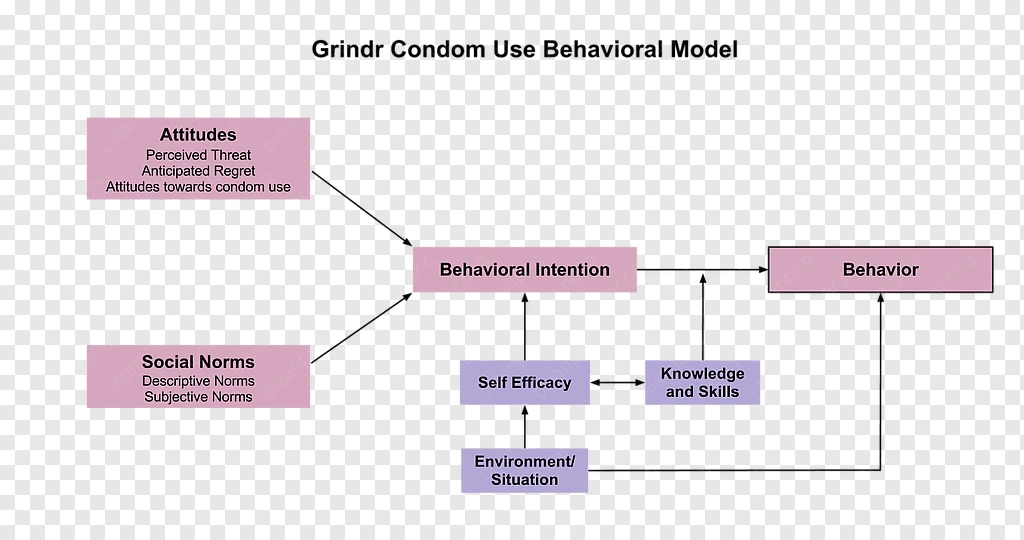 Basic research has generated a rule of thumb for at-risk populations: 40% in precontemplation, 40% in contemplation, and 20% in preparation. Across 12 health behaviors, consistent patterns have been found between the pros and cons of changing and the stages of change. Applied research has demonstrated dramatic improvements in recruitment, retention, and progress using stage-matched interventions and proactive recruitment procedures. The most promising outcomes to data have been found with computer-based individualized and interactive interventions. The most promising enhancement to the computer-based programs are personalized counselors. One of the most striking results to date for stage-matched programs is the similarity between participants reactively recruited who reached us for help and those proactively recruited who we reached out to help. If results with stage-matched interventions continue to be replicated, health promotion programs will be able to produce unprecedented impacts on entire at-risk populations.
Basic research has generated a rule of thumb for at-risk populations: 40% in precontemplation, 40% in contemplation, and 20% in preparation. Across 12 health behaviors, consistent patterns have been found between the pros and cons of changing and the stages of change. Applied research has demonstrated dramatic improvements in recruitment, retention, and progress using stage-matched interventions and proactive recruitment procedures. The most promising outcomes to data have been found with computer-based individualized and interactive interventions. The most promising enhancement to the computer-based programs are personalized counselors. One of the most striking results to date for stage-matched programs is the similarity between participants reactively recruited who reached us for help and those proactively recruited who we reached out to help. If results with stage-matched interventions continue to be replicated, health promotion programs will be able to produce unprecedented impacts on entire at-risk populations.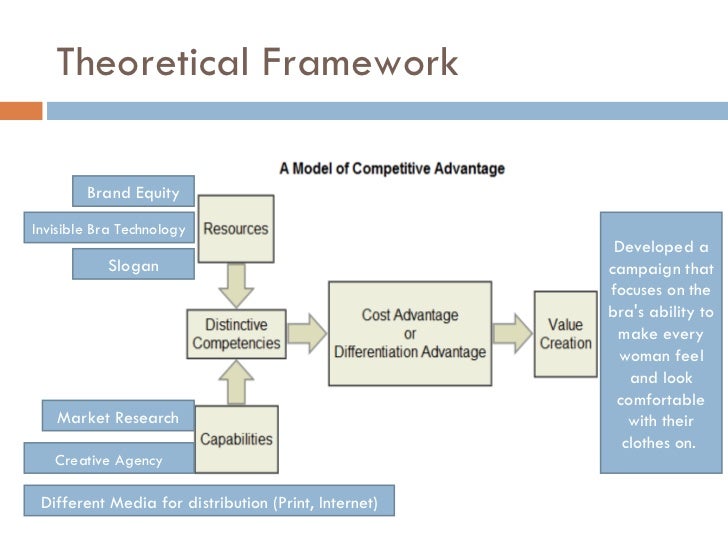
Similar articles
-
Contraceptive and condom use adoption and maintenance: a stage paradigm approach.
Grimley DM, Prochaska JO, Velicer WF, Prochaska GE. Grimley DM, et al. Health Educ Q. 1995 Feb;22(1):20-35. doi: 10.1177/109019819502200104. Health Educ Q. 1995. PMID: 7721599
-
Smoking Cessation Intervention on Facebook: Which Content Generates the Best Engagement?
Thrul J, Klein AB, Ramo DE. Thrul J, et al. J Med Internet Res. 2015 Nov 11;17(11):e244. doi: 10.2196/jmir.4575. J Med Internet Res. 2015. PMID: 26561529 Free PMC article.
-
The transtheoretical model applied to an oral self-care behavioral change: development and testing of instruments for stages of change and decisional balance.
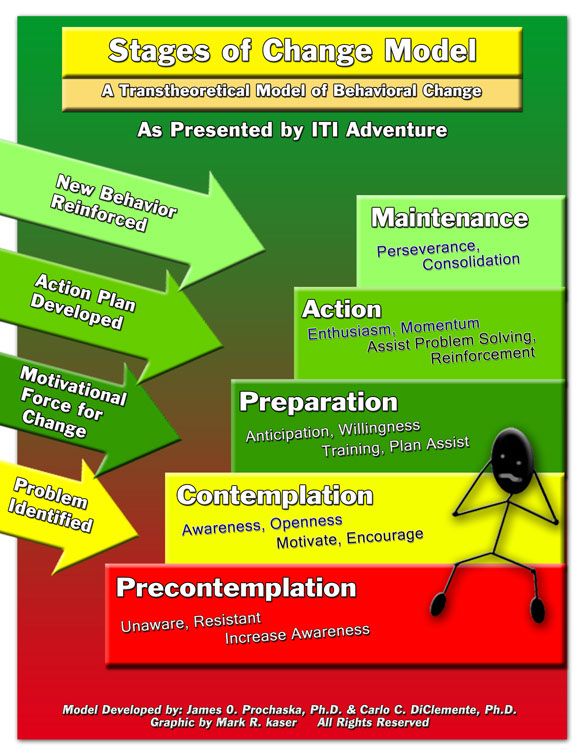
Tillis TS, Stach DJ, Cross-Poline GN, Annan SD, Astroth DB, Wolfe P. Tillis TS, et al. J Dent Hyg. 2003 Winter;77(1):16-25. J Dent Hyg. 2003. PMID: 12704966
-
Stage-based interventions for smoking cessation.
Cahill K, Lancaster T, Green N. Cahill K, et al. Cochrane Database Syst Rev. 2010 Nov 10;(11):CD004492. doi: 10.1002/14651858.CD004492.pub4. Cochrane Database Syst Rev. 2010. PMID: 21069681 Review.
-
The transtheoretical model: applications to exercise behavior.
Marcus BH, Simkin LR. Marcus BH, et al. Med Sci Sports Exerc. 1994 Nov;26(11):1400-4. Med Sci Sports Exerc. 1994. PMID: 7837962 Review.
See all similar articles
Cited by
-
An online behavior change intervention to promote physical activity in adults with asthma: study protocol for a multicenter randomized controlled trial.
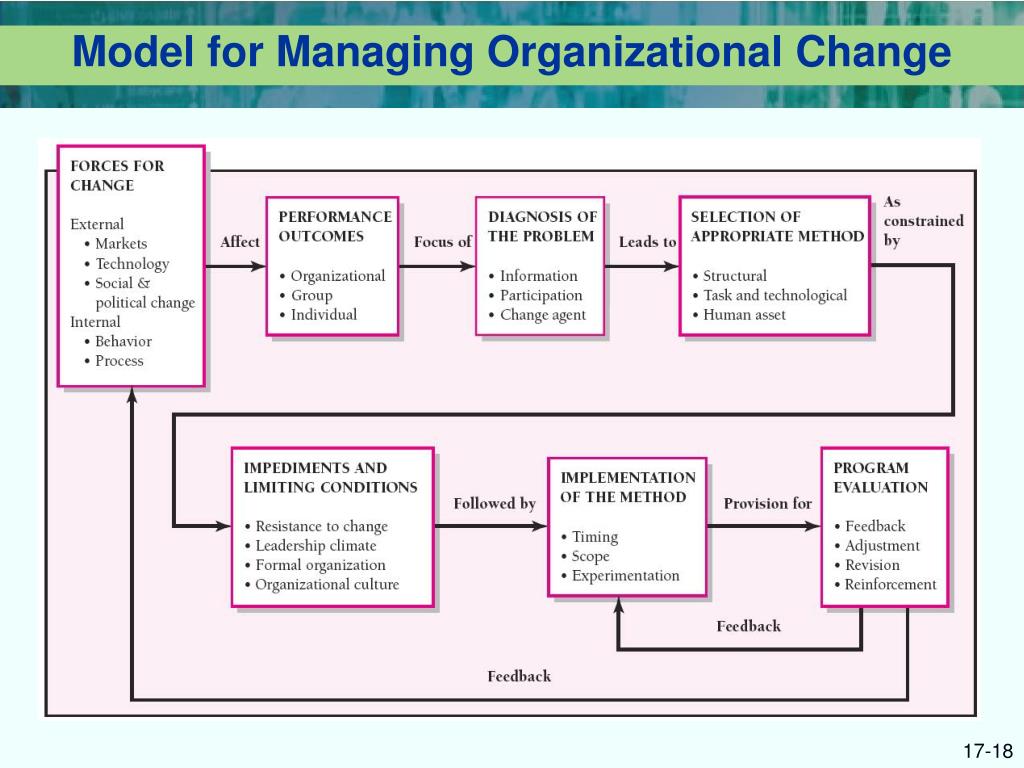
de Oliveira JM, Karloh M, Matias TS, Barbosa GB, Freitas PD, Carvalho CRF, Furlanetto KC. de Oliveira JM, et al. Trials. 2022 Dec 7;23(1):983. doi: 10.1186/s13063-022-06881-x. Trials. 2022. PMID: 36476386 Free PMC article.
-
Three-year trajectories of alcohol use among at-risk and among low-risk drinkers in a general population sample of adults: A latent class growth analysis of a brief intervention trial.
Baumann S, Staudt A, Freyer-Adam J, Zeiser M, Bischof G, Meyer C, John U. Baumann S, et al. Front Public Health. 2022 Nov 17;10:1027837. doi: 10.3389/fpubh.2022.1027837. eCollection 2022. Front Public Health. 2022. PMID: 36466482 Free PMC article. Clinical Trial.
-
Effectiveness of an integrated smoking cessation service model on smoking status: A preliminary study.
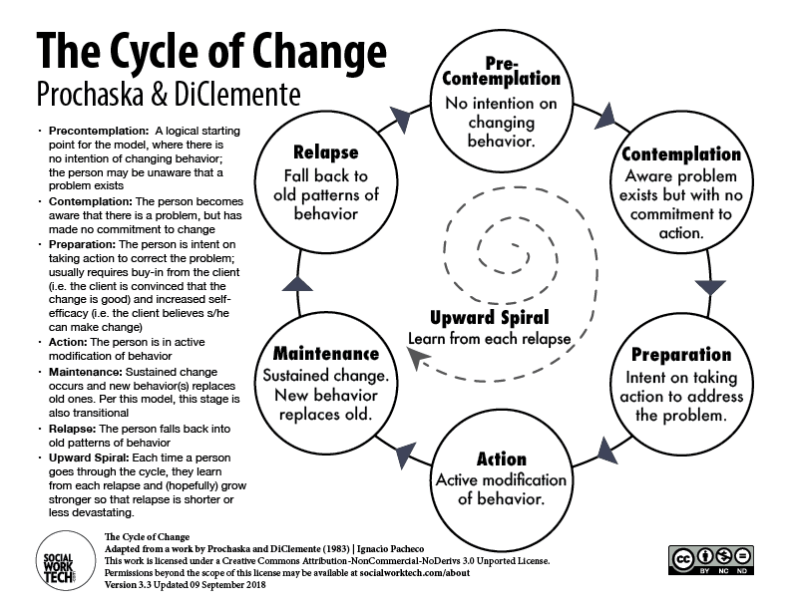
Thanomsat K, Yunibhand J, Preechawong S. Thanomsat K, et al. Tob Induc Dis. 2022 Nov 21;20:104. doi: 10.18332/tid/155375. eCollection 2022. Tob Induc Dis. 2022. PMID: 36465518 Free PMC article.
-
Adverse childhood experiences, recent negative life events, and non-suicidal self-injury among Chinese college students: the protective role of self-efficacy.
Chen Z, Li J, Liu J, Liu X. Chen Z, et al. Child Adolesc Psychiatry Ment Health. 2022 Dec 3;16(1):97. doi: 10.1186/s13034-022-00535-1. Child Adolesc Psychiatry Ment Health. 2022. PMID: 36463208 Free PMC article.
-
Addressing people's current and future states in a reinforcement learning algorithm for persuading to quit smoking and to be physically active.
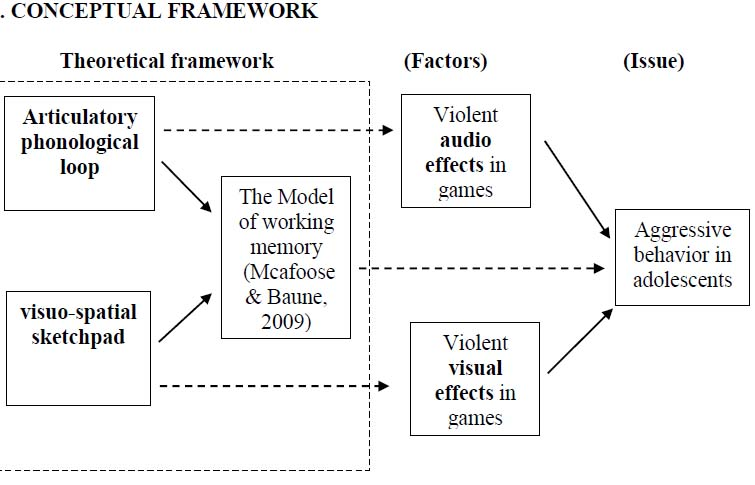
Albers N, Neerincx MA, Brinkman WP. Albers N, et al. PLoS One. 2022 Dec 1;17(12):e0277295. doi: 10.1371/journal.pone.0277295. eCollection 2022. PLoS One. 2022. PMID: 36454782 Free PMC article.
See all "Cited by" articles
Publication types
MeSH terms
Grant support
- CA 27821/CA/NCI NIH HHS/United States
- CA50087/CA/NCI NIH HHS/United States
- HC 48190/HC/NHLBI NIH HHS/United States
how to turn a customer into a loyal customer
If the customer does not know anything about your product, then you will have to spend time and make some effort to sell it. But the strategy of "persuasion step by step" can come to the rescue.
Transtheoretical model of behavior change - persuasion step by step
A comprehensive model that demonstrates changes in human behavior was developed by psychologists J.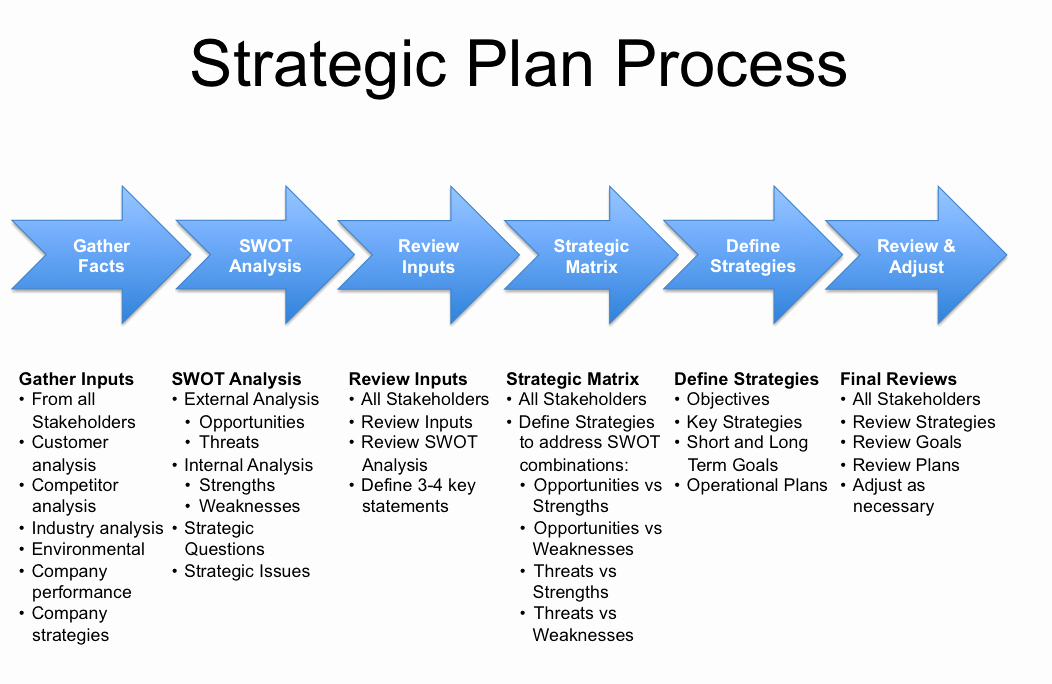 Prochaska and C. Diclemente in 1994 and described in the work “Stages of change and decision-making balance for 12 problematic types of behavior ". The process of behavior change has been studied from the point of view of various theories, so the model is called transtheoretical. nine0003
Prochaska and C. Diclemente in 1994 and described in the work “Stages of change and decision-making balance for 12 problematic types of behavior ". The process of behavior change has been studied from the point of view of various theories, so the model is called transtheoretical. nine0003
J. Prochasca and C. Diclemente
The transtheoretical model is a comprehensive multifactorial concept of the process of changing human behavior. The possibilities of practical use of the transtheoretical model are enormous. It is used in a variety of areas - from the fight against smoking and overweight to the prevention and fight against juvenile delinquency.
It has also been widely used in marketing. Using this model, you can extremely effectively influence the behavior of consumers, turning them into repeat customers. nine0003
The community is now on Telegram
Subscribe and stay up to date with the latest IT news
Subscribe
5 stages of the step-by-step persuasion strategy
How to make the consumer move from the stage of completely ignoring your product to the stage of transformation integral part of his life? How to start an advertising campaign and effectively reach the planned result? The transtheoretical model of persuasion is here to help!
The transtheoretical model has 5 stages.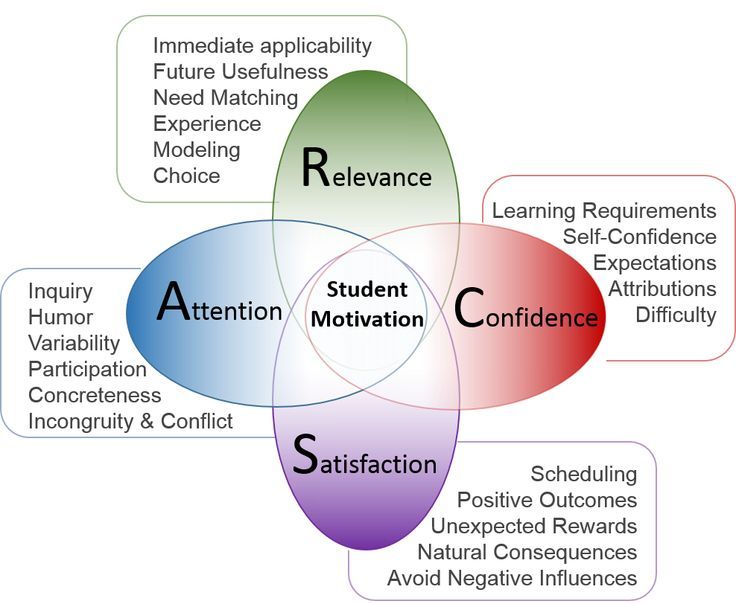 Each stage assumes a certain level of knowledge of the consumer about the product and behavior corresponding to this level of knowledge. nine0003
Each stage assumes a certain level of knowledge of the consumer about the product and behavior corresponding to this level of knowledge. nine0003
Consider the passage of these stages by the consumer on a specific example. Let's say you have an online school for creating websites. You teach web site development from scratch to PRO level. You train front-end, back-end and full-stack developers (full-cycle developers). Your courses teach programming languages such as HTML, CSS, JavaScript, PHP, Java, C, Python, Ruby, work with libraries and databases, and also equip you with advanced technologies. You have a serious professional approach to learning. After training, your students are not only capable of simple projects, they are also able to implement really complex things developed in a pure programming language. Your courses are not that easy to learn, but you solve this problem by using a radical new author's teaching method on which your learning system is based. If you do not have such a unique technique, develop it. You position yourself as an authoritative expert who thoroughly knows what he teaches. nine0003
You position yourself as an authoritative expert who thoroughly knows what he teaches. nine0003
Stage 1: Prethinking
At this stage, the consumer does not yet have the intention to change anything in his life. He doesn't know anything about your product and avoids situations that could change his behavior. He does not show interest in new products and is not inclined to discuss them. A person exaggerates the positive aspects of his course of action and underestimates the benefits of another product.
Stage 2: Thinking
In the contemplation stage, a person is already considering the possibility of changing his behavior. At this stage, the consumer studies the product, usually evaluates the pros and cons as approximately equal, and they are equally important to him. The results are still unpredictable.
At this stage, potential buyers are already aware of the existence of your product and are considering the prospect of using it: “Maybe you should try this course.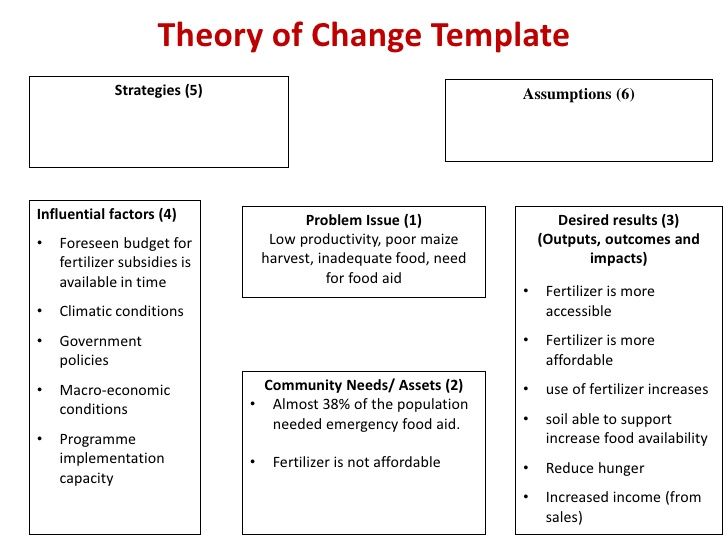 But writing code yourself... It's hard. Apparently, some basic knowledge, some training are needed. nine0003
But writing code yourself... It's hard. Apparently, some basic knowledge, some training are needed. nine0003
Stage 3: Preparation
The preparation stage is characterized by the fact that the person already has the intention to change his attitude towards the product in the near future. He may have made some attempts, but now he is clearly taking more confident steps towards changing the attitude towards your product. At the preparation stage, the pros already outweigh the cons, although both are still important to the consumer. Empirical ways of thinking are used by him more and more intensively. nine0003
This is the planning phase. Your potential buyer is already thinking about purchasing your product, but he still needs some information about its advantages and benefits: “I would like to buy this course ... Tired of making business card sites already! Yes, and money from them ... Probably, after completing the course, I will be able to take on complex projects.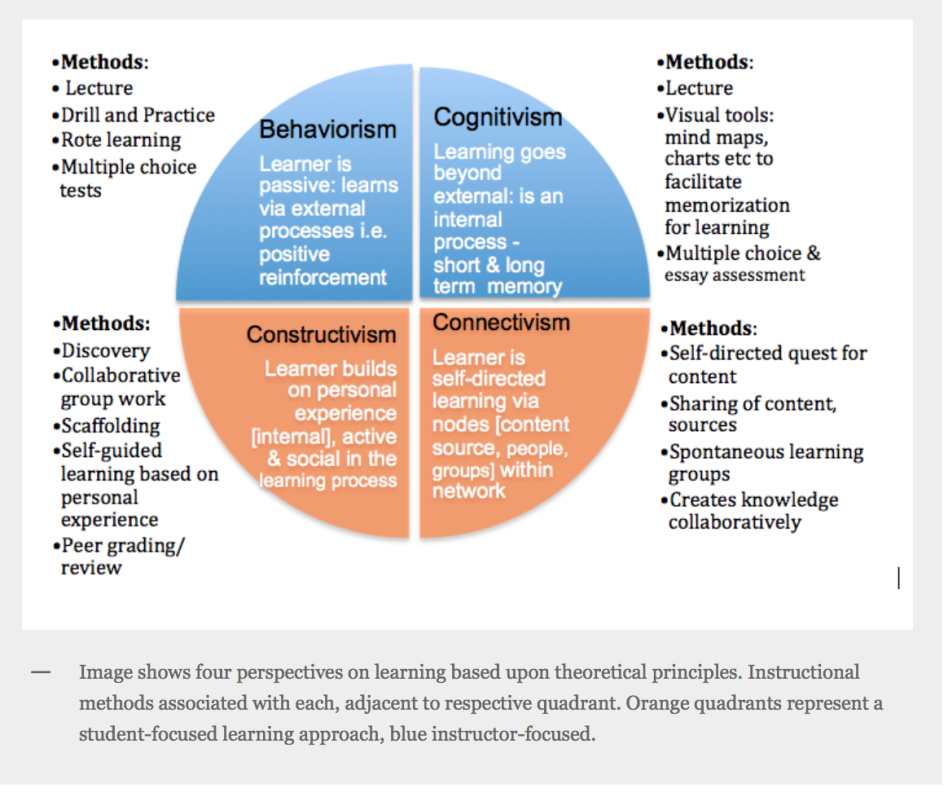 A completely different client will come to me. Bring more money! If there is a desire, I can get a decent job. The prospects are tempting... But what is this course? Why is it better and more useful than others? What is the miraculous system of education? Or is it really easier? Will I be able to handle it?" nine0003
A completely different client will come to me. Bring more money! If there is a desire, I can get a decent job. The prospects are tempting... But what is this course? Why is it better and more useful than others? What is the miraculous system of education? Or is it really easier? Will I be able to handle it?" nine0003
Stage 4: Action
The action stage indicates a decisive change in behavior and is characterized by the stable maintenance of a new style of behavior. But the problem of relapse, a return to the previous behavior, still persists, although it is no longer so acute.
Success! Your potential buyer has come to the phase of the desired action, that is, the purchase: “Here is my credit card, give me this rate already!”.
Stage 5: Maintenance
At this stage, the behavioral change is obvious, the likelihood of unwanted behavior is very low, and there is no return to the past.
The best phase in which you would like to always see potential customers.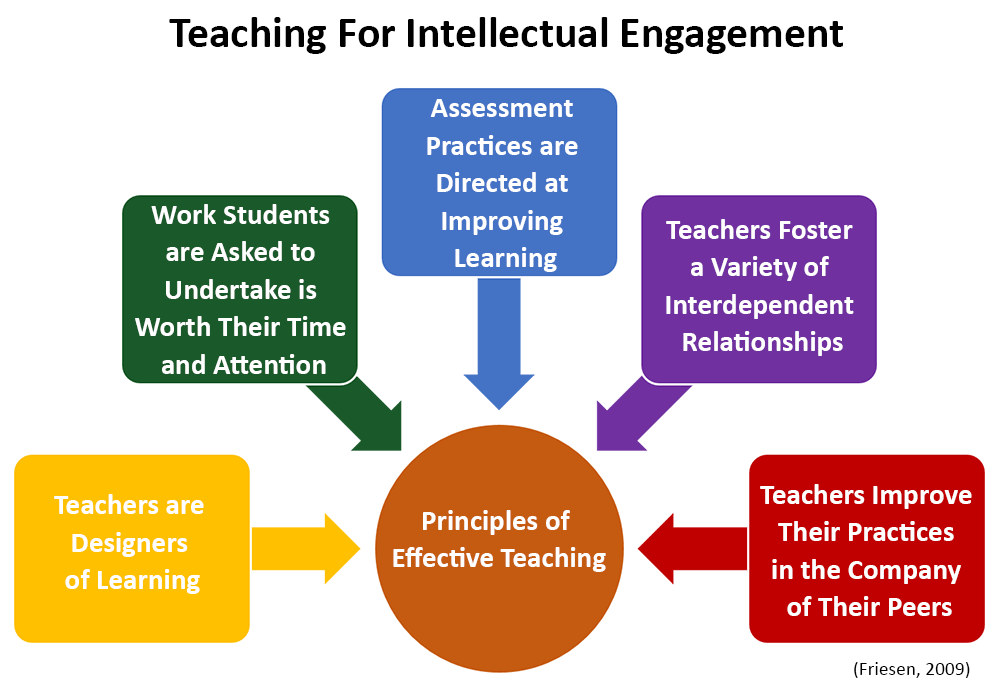 At this stage, your product has already become part of the daily life of customers. They continue, without hesitation, to buy your courses. It is your courses that they choose. Everything is extremely simple: when they want to go further, when they want to improve their professional level, acquire new knowledge, master new programming languages and reach new heights in web development, they come to you. nine0003
At this stage, your product has already become part of the daily life of customers. They continue, without hesitation, to buy your courses. It is your courses that they choose. Everything is extremely simple: when they want to go further, when they want to improve their professional level, acquire new knowledge, master new programming languages and reach new heights in web development, they come to you. nine0003
How to Apply the Step by Step Persuasion Strategy
Your goal is to gradually guide your customers through all 5 stages so that using your product becomes a habit and a necessary part of their life.
What is the difficulty in applying this strategy? The difficulty is that you need to successfully interact with groups of consumers who are at different stages of the process of getting to know your product. Some of your potential buyers are in the first stage, and others do not even think about other courses, having reached the fifth.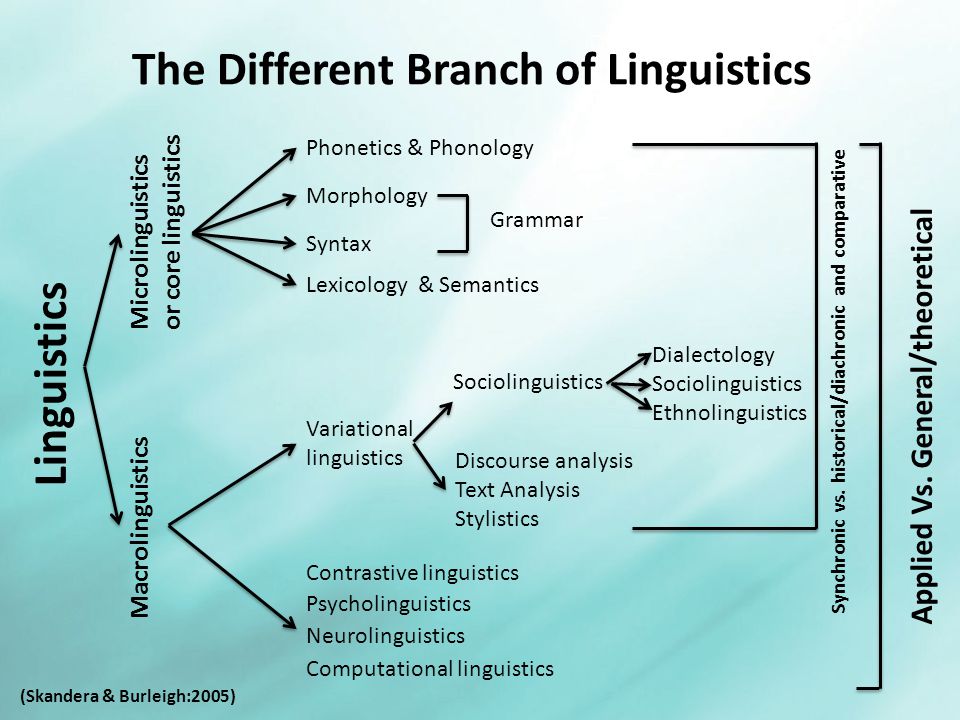 nine0003
nine0003
You have two options:
- Come up with an ad that appeals to consumers in all five stages. This will allow potential buyers to focus on the stage that is currently relevant for them. Just include in your ad everything that the consumer needs to form an idea about your product, form an opinion, and make a purchase decision.
- Create a series of commercials (ads) that will replace each other after some time, moving from stage 1 to stage 5. Thus, the first video (ad) will introduce your product to the market, and each subsequent video (ad), based on on the previous one, will highlight the key benefits and benefits of your product. nine0092
This way you can lead your potential customers through all 5 stages of behavior change, providing enough information and motivation to become regular customers.
The application of this strategy is extremely effective, as it aims to develop an attitude of long-term and stable preference for your product to others.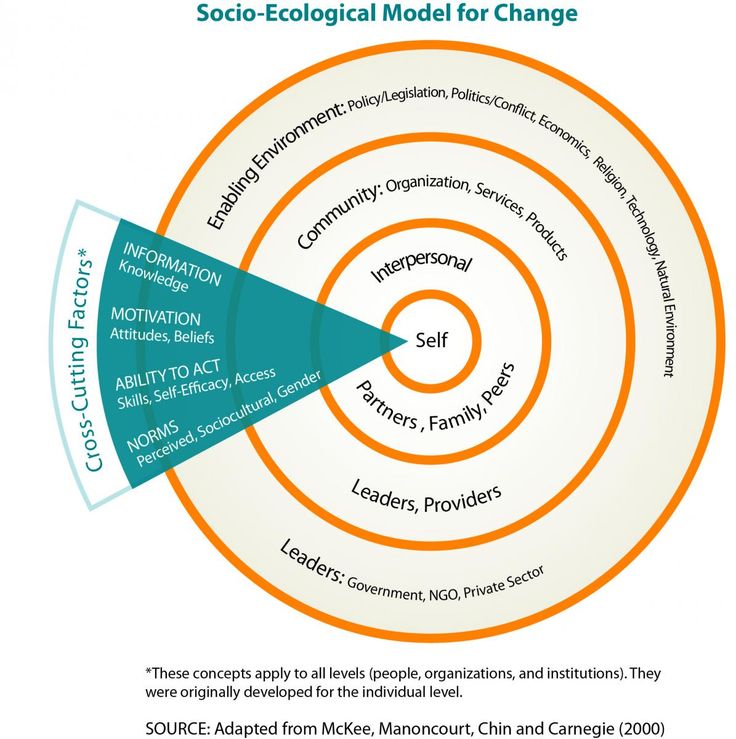 Using your product becomes a habit and becomes vital. Try it, and the desired results will not be long in coming. nine0003
Using your product becomes a habit and becomes vital. Try it, and the desired results will not be long in coming. nine0003
Want a loyal customer to stay with you for the rest of your life? Then we need to work a little more and strengthen the conquered frontiers and heights. And there is another strategy for this.
Theory of vaccination. Be chosen for life
Inoculation theory (attitude inoculation) uses methods that can increase people's confidence in their own beliefs and help maintain their position in the face of undesirable outside influences.
The vaccination theory was developed by Yale University social psychologist William J. McGuire, who was looking for an answer to the question of whether it is possible to give "vaccinations against unwanted information exposure" by analogy with vaccinations against viral diseases. The mechanism of the inoculation theory is similar to the medical process of vaccination. A medical vaccine consists of weakened virus cells. After the introduction of the vaccine, the human body begins to fight, producing antibodies, and defeats the virus, becoming immune to it. With medical inoculation, a dose of antigenic material is introduced, and when applying the theory of inoculation, doses of information are offered that contradict the existing ideas of man. nine0003
After the introduction of the vaccine, the human body begins to fight, producing antibodies, and defeats the virus, becoming immune to it. With medical inoculation, a dose of antigenic material is introduced, and when applying the theory of inoculation, doses of information are offered that contradict the existing ideas of man. nine0003
Information that contains a small threat to a person's beliefs helps develop "immunity" to such messages and allows you to successfully defend your position in a more serious attack, strengthening confidence in beliefs.
In marketing, grafting theory is used to reinforce a consumer's existing opinion of a product by presenting a weak "against" argument that forces the buyer to defend his position, put forward counterarguments, and become increasingly convinced of the correctness of his opinion. nine0003
Three stages of the vaccination strategy
Let's go back to the online school of website building. Let's take an example.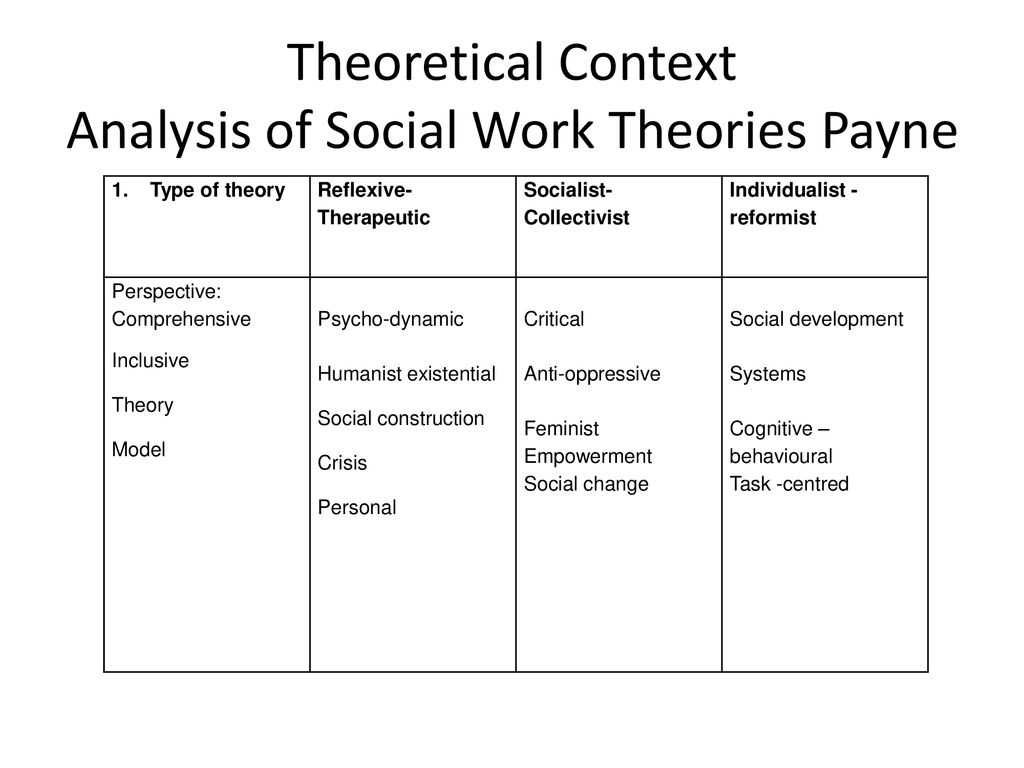 Analyzing the activities of competitors, you notice that someone is selling a course on a topic similar to yours at a lower price. This fact is already eloquently told by a competitor's advertisement. You are well aware that when comparing the price, a potential buyer may prefer the rate of competitors, since it is cheaper.
Analyzing the activities of competitors, you notice that someone is selling a course on a topic similar to yours at a lower price. This fact is already eloquently told by a competitor's advertisement. You are well aware that when comparing the price, a potential buyer may prefer the rate of competitors, since it is cheaper.
You have reviewed the course content of your competitors and concluded that your course provides significantly more information on the topic. Your course reveals it more fully, the material is better structured, there are much more practical exercises that are a logical continuation of the theoretical blocks. nine0003
The use of a vaccination strategy will help to communicate your conclusions to consumers and justify the high price. One way to use grafting theory is to publish critical assessments of competitors in the form of weak attacks and turn those assessments into your own advantage.
Make the starting point of your actions the competitor's claim that their price is the lowest in the market and that all others offer similar courses at a higher price.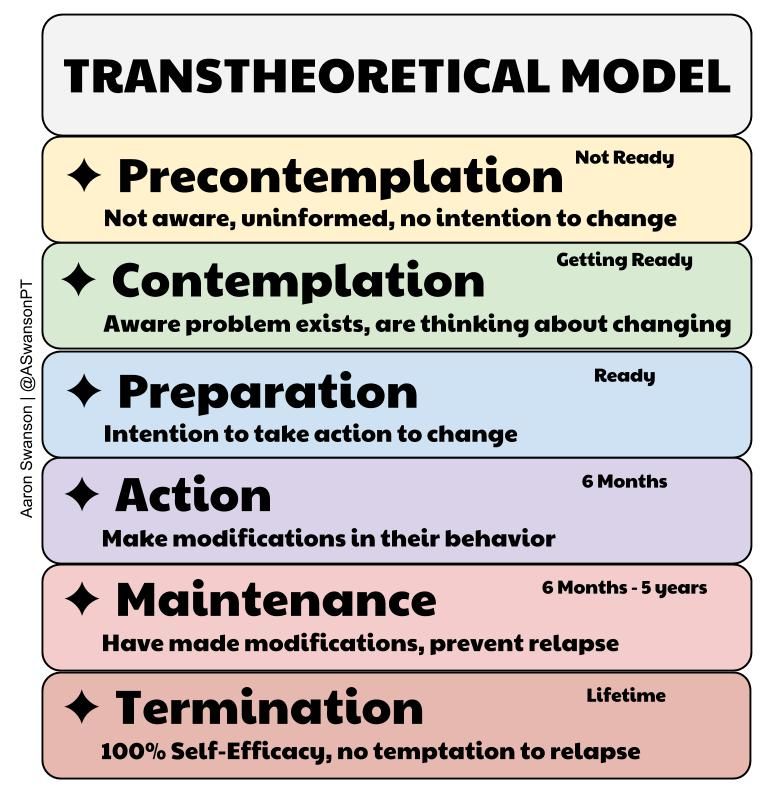 And then use the vaccination strategy. nine0003
And then use the vaccination strategy. nine0003
The theory of inoculation involves three stages.
Warn of an approaching attack
Start a discussion on your site. Write: “Competitors say that our course is expensive, that they can offer a similar one at a lower price. But they don’t say anything about the fact that their course is completely devoid of three important theoretical blocks (write their names) and 10 practical lessons on them, which are necessary for developing skills... Perhaps, if we remove these three blocks and 10 practical lessons, we We can make our course even cheaper than our competitors.” nine0003
Your task at this step is to warn users of the impending danger and provoke a response. You must force them to prepare for a possible attack: strengthen the defense and prepare counterarguments.
Weak Attack
In this step, you begin to attack lightly. Stir up your audience with a few weak arguments in favor of what you are planning to do: “Maybe we could go for a way to shorten the course, remove some topics and practical exercises.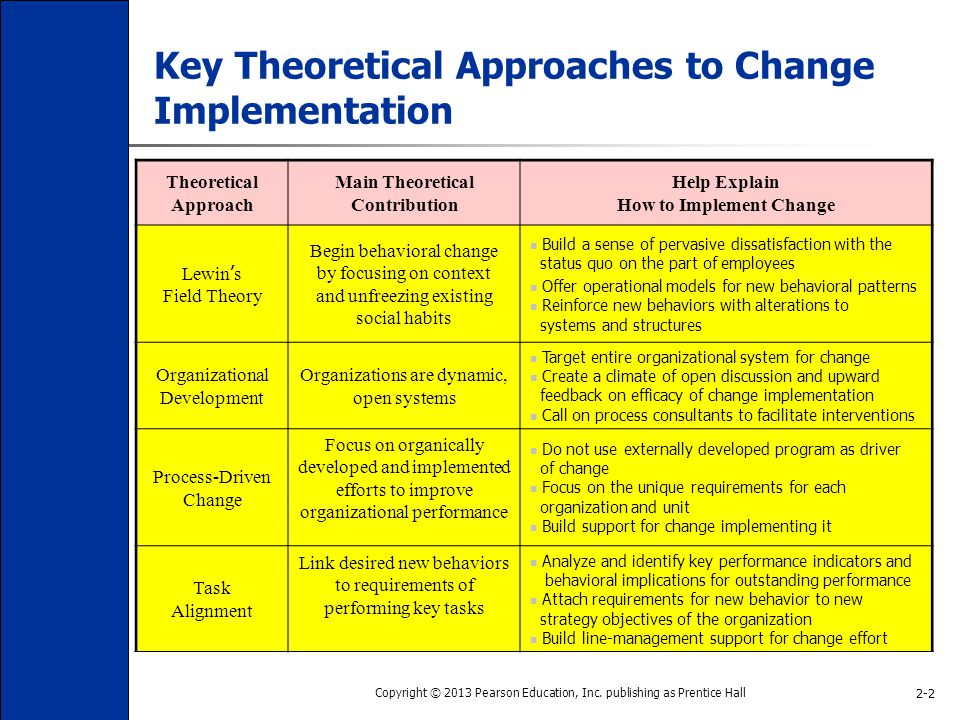 This will probably deprive our students of the opportunity to acquire certain knowledge and skills, but it will make the course cheaper. These topics can be given for independent study ... So what do you think? nine0003
This will probably deprive our students of the opportunity to acquire certain knowledge and skills, but it will make the course cheaper. These topics can be given for independent study ... So what do you think? nine0003
Encourage fierce defense
This strategy will get your users to say whatever they think about it. The inoculation strategy will force users to think critically, become more aware of their position, strengthen their defenses, and prepare for a counterattack.
Note that it is important not to overdo it here. Your attack must be convincing but weak. Non-essential arguments against beliefs contribute to the development of defensive counter-arguments that strengthen confidence in the correctness of one's position. Otherwise, you risk achieving the opposite effect and changing the opinion of potential buyers about your product. nine0003
Thus, by applying the vaccination strategy, you can refute all the advertising arguments of your competitors.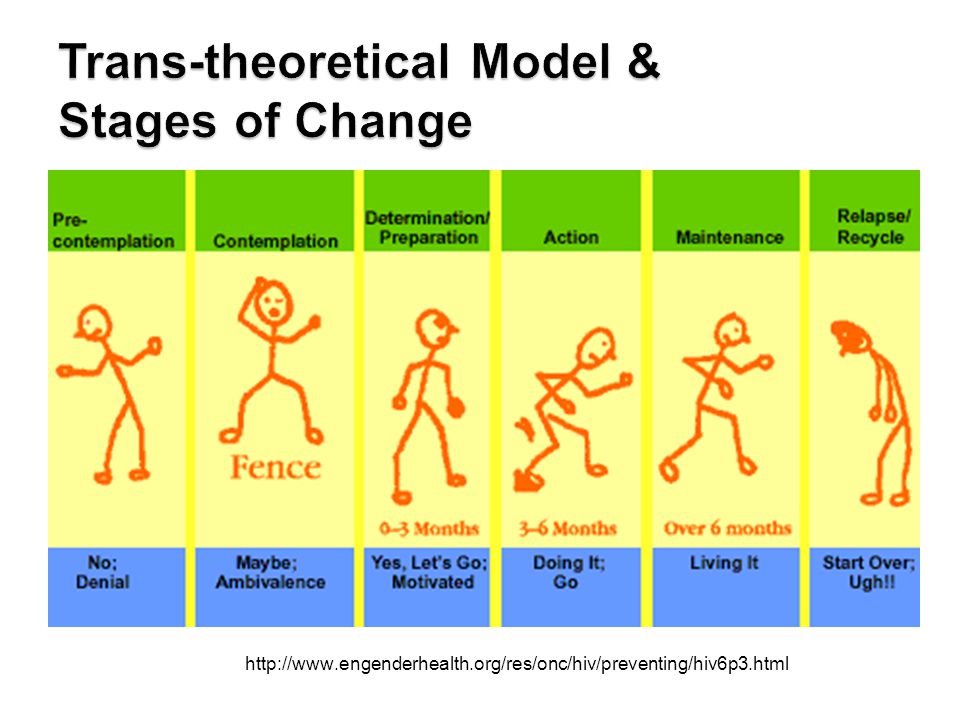 If you provide reliable information, then your advertising becomes something more than just another advertising cry. This enhances your credibility. You are pushing potential customers to pass all the words of your competitors through your filter.
If you provide reliable information, then your advertising becomes something more than just another advertising cry. This enhances your credibility. You are pushing potential customers to pass all the words of your competitors through your filter.
Such advertising leads to the fact that there are more and more critical buyers who are inclined to purchase your products. Think about what you do faster, better and easier? Inoculate potential customers by bringing these benefits to the surface and watch how you win them over. nine0003
How we become different or necessary steps in the process of changing our behavior
Year of publication and journal number:
2017, No. 1
Author:
Yagnyuk K.V.
Abstract
An informative article on the transtheoretical model of behavioral change by Prochazka, Norcross and Di Clemente. It tells about the stages through which a person goes in the process of changing his behavior.
Keywords : behavioral change, stages of change, transtheoretical model.
A huge number of people have been trying for years to change something in their lives, struggling to find an effective solution to their problems. According to the transtheoretical model of behavior change by American psychotherapists James Prochazka, John Norcross and Carlo Di Clemente, change is a process that has a number of stages. They can not be skipped, everyone has to go the same way. Anyone who has tried to change some of their addictions is familiar with the situation when, in order to allay feelings of guilt and anxiety, we make a promise to ourselves to start a “new life” the very next day. And quite often we do that. But usually the action without a preparatory stage lasts a day, two, a maximum of a week. Experience shows that many of those who make a promise to themselves to start a new life at some point report doing so for a number of years before they manage to achieve lasting change. Empirical research shows that to really change your behavior, you need a solid foundation, which is laid by gradual, authentic progression through the stages of change.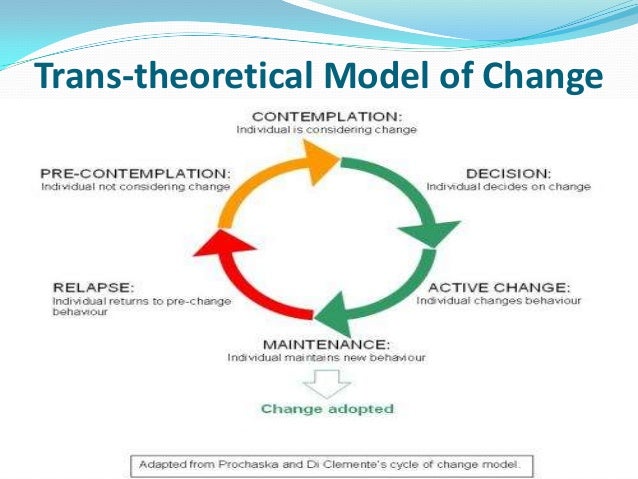 What are these necessary steps in the process of changing your problematic behavior? Let's look at them in more detail. nine0003
What are these necessary steps in the process of changing your problematic behavior? Let's look at them in more detail. nine0003
Resistance to change
In most cases, the starting position is active resistance to change. The hallmark of this stage is the resistance to admitting there is a problem. Those at this stage may believe that they have flaws, but do not agree that they need to change something in themselves. However, it is often obvious to people from their immediate environment - family members, friends, colleagues, that the problem is very serious. At this stage, individuals are not sufficiently aware of their problems, deny them, and in one way or another defend themselves against attempts by others to point them out. When such people come to a psychotherapist, then, as a rule, they do it under the influence of others. Usually they are pushed to change by a marriage partner or a parent. "Resistant" may give in to pressure and pretend that they recognize the problem and want to change, but, in reality, they are not at all considering changing their behavior in the foreseeable future.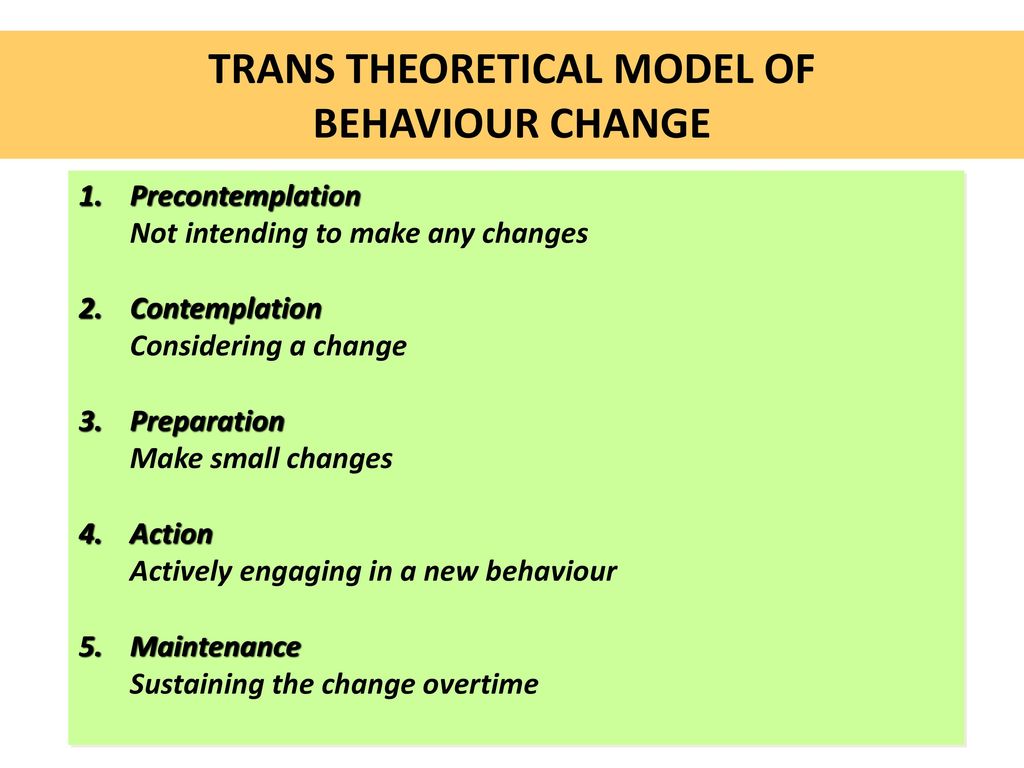 As you know, knowledge is power, so the first step towards conscious change is to recognize the problem, realize its negative aspects and the consequences of your harmful behavior. nine0003
As you know, knowledge is power, so the first step towards conscious change is to recognize the problem, realize its negative aspects and the consequences of your harmful behavior. nine0003
Thinking
At this stage, people recognize the fact of the problem and begin to seriously consider ways to solve it. They are trying their best to understand its essence, to get to the bottom of the reasons, to consider possible solutions. But they are still far from translating these intentions into behavior. Ponderers consider various options, making sure many times that the problem will not be solved by itself. At this stage, people can linger for a long time - often for years. To move forward, it is very important to avoid the trap of mental chewing, that is, chronic overthinking, which, in reality, leads nowhere. Seriously considering the consequences of the existing problem, angry at themselves for being in this position, contemplatives gradually come to a firm decision to take action.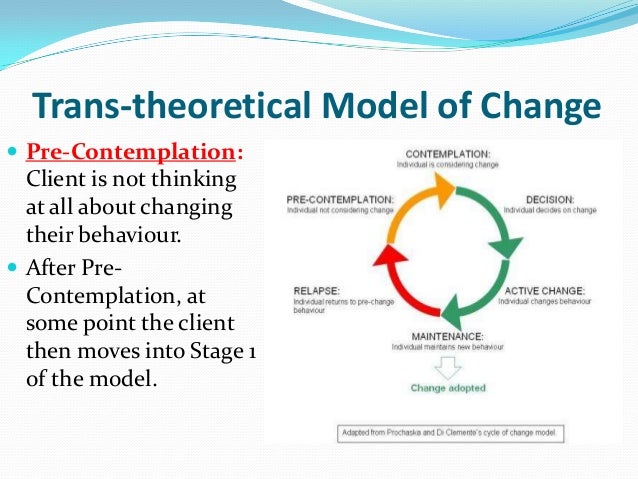 Timid, trial actions become a step towards the transition to the next stage. The end of the contemplation phase is a time of anticipation, anxiety, and excitement. nine0003
Timid, trial actions become a step towards the transition to the next stage. The end of the contemplation phase is a time of anticipation, anxiety, and excitement. nine0003
Preparing
Most of those who are in the preparatory phase are planning to go into action as early as next month and are making final adjustments to their plans. They didn't necessarily get over their indecisiveness. They still have to convince themselves that their decision is the only right one. The preparation stage is characterized by the unification of efforts and the preliminary actions taken. This leads to some success in eliminating problem behaviors, but they have not yet reached the desired result, for example, a person who wants to quit smoking may significantly reduce smoking, but has not yet completely abandoned it. Like any person who is on the threshold of important accomplishments, individuals in the preparation stage need to determine their goals and priorities, because change requires effort, attention and energy. To move to the stage of action, this goal must become a matter of paramount importance for them. They must think in detail and decide to stick to the action plan they have developed. nine0183
To move to the stage of action, this goal must become a matter of paramount importance for them. They must think in detail and decide to stick to the action plan they have developed. nine0183
Action
At this stage, individuals move from thinking and talking to doing. Of course, actions require significant volitional efforts, energy and time costs. In order to interrupt habitual, problematic patterns of behavior and avoid breakdowns and relapses, individuals have to simultaneously monitor the pitfalls that can get in the way of changing their behavior. The action phase lasts several months. The first two months are the most dangerous period in terms of relapse. Saving changes builds on the work done in the previous steps. Success in changing one's behavior is deservedly accompanied by a sense of pride in oneself (“Anyone can talk about changes, but I take certain actions to change”). The changes achieved at this stage are the most noticeable to other people, therefore they receive the maximum external recognition and support.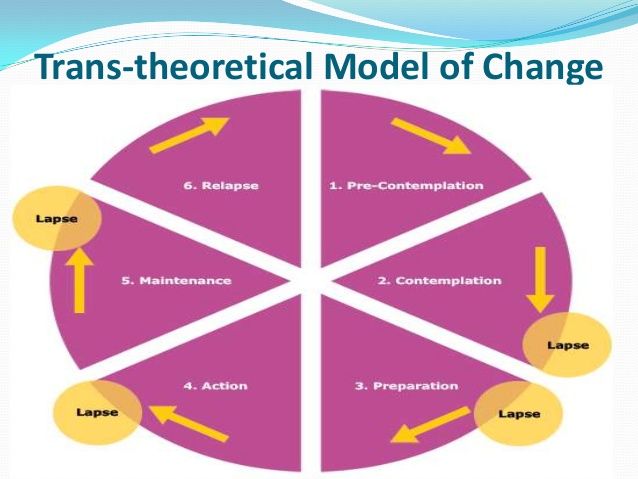 nine0003
nine0003
Save
Save is not a static position, but a continuation of change. Without a strong intention to build on what has been achieved, relapse is almost 100% likely, so the transition from action to implement change to maintain change is critical. The goal of the change retention phase is nothing less than a permanent change that becomes part of the personality and a new way of life. In this stage, individuals work to prevent relapse and reinforce the change that has already been achieved. In the case of chronic problems, this stage lasts after the initial actions from six months to an indefinite period of time. For serious chronic problems such as alcohol or drug addiction, the retention stage can be lifelong. A distinctive feature of conservation is the stabilization of behavioral change and the prevention of relapse. nine0003
As already mentioned, when individuals attempt to abandon chronic problem behaviors, relapses and re-stages occur quite frequently. With serious chronic problems such as addictive behavior, linear progression through the stages is a possible but very rare phenomenon, rather an exception to the rule. In the event of a relapse, individuals regress to an earlier stage, such as the stage of preparation or reflection. A relapse is usually accompanied by feelings of frustration, shame, and guilt. Those who are very sensitive to relapse and see themselves as failures may find themselves demoralized and driven away from thoughts of behavioral change. As a result, they return to the stage of resistance to change and can remain there indefinitely. However, as experience shows, most of those who fail do not go around endlessly in circles and do not return to the starting point, losing everything they have acquired. Through their attempts, they are more likely to learn something and next time they try to avoid previous mistakes by behaving differently. That is why the authors of this model prefer to use the term “recycle” rather than relapse.
With serious chronic problems such as addictive behavior, linear progression through the stages is a possible but very rare phenomenon, rather an exception to the rule. In the event of a relapse, individuals regress to an earlier stage, such as the stage of preparation or reflection. A relapse is usually accompanied by feelings of frustration, shame, and guilt. Those who are very sensitive to relapse and see themselves as failures may find themselves demoralized and driven away from thoughts of behavioral change. As a result, they return to the stage of resistance to change and can remain there indefinitely. However, as experience shows, most of those who fail do not go around endlessly in circles and do not return to the starting point, losing everything they have acquired. Through their attempts, they are more likely to learn something and next time they try to avoid previous mistakes by behaving differently. That is why the authors of this model prefer to use the term “recycle” rather than relapse.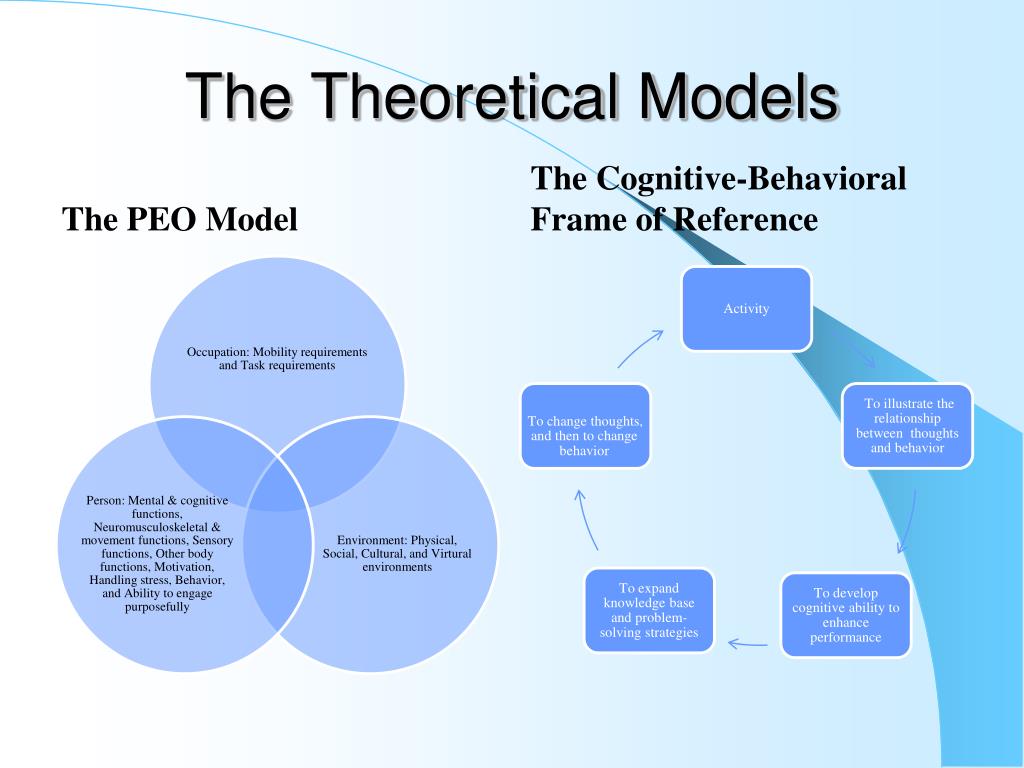 The repetition provides an opportunity to learn. Those who act and fail are more likely to succeed next time. nine0003
The repetition provides an opportunity to learn. Those who act and fail are more likely to succeed next time. nine0003
The completion stage is the ultimate goal of all those who work on themselves. At this stage, the old problematic behavior or addiction is no longer a temptation or threat. Problem resolution characterizes the state when the person is no longer tempted to revert to the problem behavior and no longer needs to make efforts to keep from relapse. He won the battle and went through the whole cycle to the end.
For those whose problem remains unresolved for a long time spent on its own to overcome it, it's time to think about contacting a specialist. Any person embarking on the path of self-change needs supportive relationships to help them stay hopeful and meet the challenges of each stage. A counseling psychologist or psychotherapist has the necessary knowledge and skills and can help you change your life for the better. nine0003
The further clients have progressed through the stages of change on their own, the more progress they can make in psychotherapy.